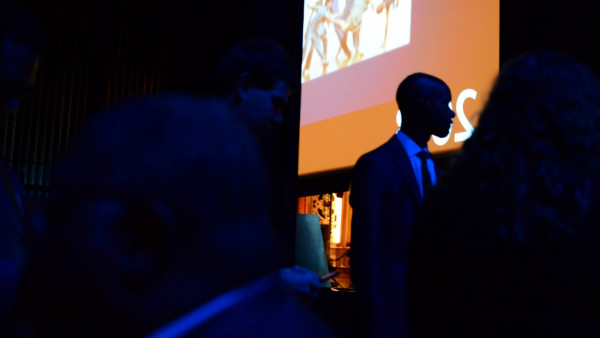Wynton Marsalis, Jazz at Lincoln Center Orchestra Wildly Entertaining
Wynton Marsalis and the Jazz at Lincoln Center Orchestra, with three incredible dancers — tap star Jared Grimes and jook virtuosi Charles “Lil Buck” Riley and Ron “Prime Tyme” Myles — captivated a sold-out house at The Granada Theatre on Saturday night.
UCSB Arts & Lectures kicked off its 60th anniversary season with a shot of artistic epinephrine, a welcome counterpoint to recent acts on the national stage.
Marsalis’ 2016 work “Spaces” captures in richly varied jazz and dance dialects the taxonomies, habits and movements of 10 animals, and the archetypes they represent.
We followed the searchlights and were greeted outside the theater by a local college jazz quartet and a crowd abuzz with anticipation.
Among the 15 superb JLCO musicians onstage (all male), Marsalis modestly resided in the back with fellow trumpeters.
Though centered on jazz instrumentation, naturally, “Spaces” embodies the symbiosis of musicians and dancers. Neither is accompaniment. Marsalis introduced each animal with science, myth and parallels to human behavior, punctuated with entertaining, self-reflexive pauses.
“Snakes are importantly associated with male sexuality … and that association is the conduit through which they have been connected to untrustworthiness” … pause…
“Elephants are the first trumpeters” … pause … (Ironically, in “Pachyderm Shout,” Marsalis played washboard alongside New Orleans parade-inspired brass.)
Nightingales, he said, “can improvise up to 300 songs. That’s why they’re sometimes compared to jazz musicians. They sing in the dark of night as well as the first light of dawn. They do late-night things. They have to do that, in order to have something to sing about.” Pause.
On that note, “A Nightingale” was the only segment with no dancing. It belonged to the musicians alone.
The bird on a summer night came to life through high-end plucking on the bass; flute pyrotechnics; swift stippling across the high keys; sultry clarinet; a contemplative midnight trumpet; and solos that captured musicians’ sometimes solitary nocturnal life.
Honoring bees and frogs, swallows and chickens, lions and monkeys showcased the music and the musicians’ expressive breadth.
As elephants, instruments in the lower range — bass, tuba, baritone sax — came to the top. Muted trombones spoke of penguins’ “high society.” The orchestra called to mind a flight of swallows, a lone snake, Indian temples, the African savannah and barnyard shenanigans.
The performance tickled ears, eyes, mind and heart, integrating music and dance, lighting and language — even fashion.
Evoking the sly snake, trumpeters muted their horns with dapper white hats and, as a pair of gentlemen penguins, Grimes and Riley donned black blazers and bowlers.
When introducing the dancers, Marsalis noted, “Words would diminish what they do.” Nevertheless …
As a snake, Riley’s wavy arm span defied jointedness. Folded arms were the swishing ears of an elephant, and he became a one-man parade of them with outstretched, full-body reaching.
In jook lexicon, dancers spin, hop, twirl and stroll on the edges of their feet, apparently unencumbered by ankles. Damian Woetzel’s ballet-steeped choreography featured silky turns “en pointe,” albeit in wingtips and Air Jordans.
Grimes’ tapped rhythms were integral to the orchestration, sometimes in call-and-response with the drums.
In “Bees, Bees, Bees,” he shadowed Myles, giving staccato voice to Myles’ rapid-fire footwork while concealed behind him.
And in debate with the band, he depicted — with astonishing stamina, majestic comportment and breakneck speed — the unrelenting fight of a lion king to remain on top of the pride.
While the audience shuffled out after “curtain,” Marsalis moved downstage with his horn plus three other musicians and the dancers for a spirited encore jam.
By Judith Smith-Meyer
Source: Noozhawk

